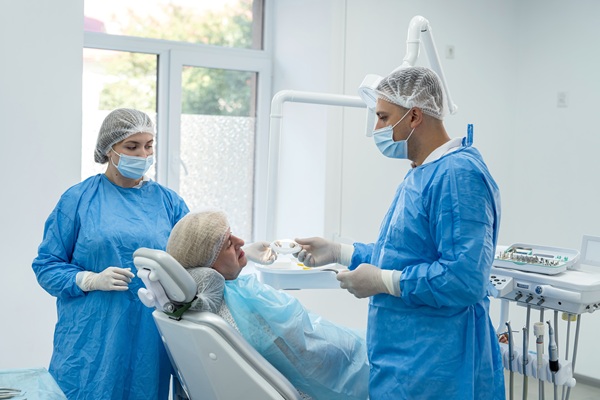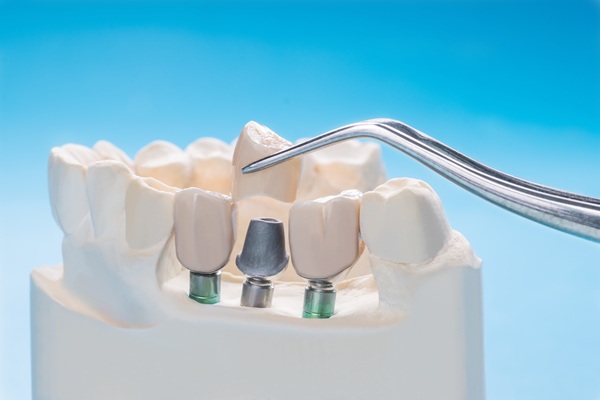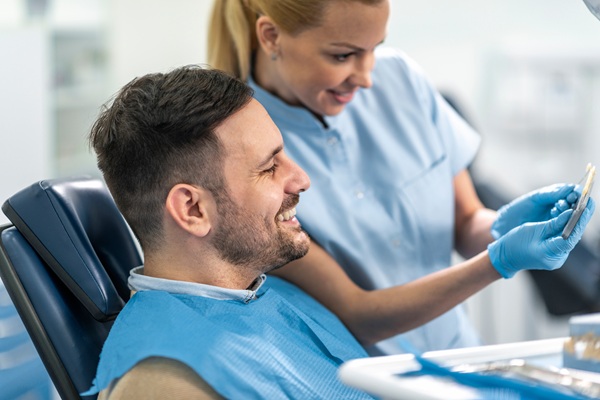
Osseous Surgery (Gum Surgery)Woodland Hills, CA
Osseous surgery is a form of gum surgery that treats gums affected by periodontal disease. Periodontal disease attacks the structures that support the teeth, thus threatening one's overall oral health. It is also known as gum disease. Osseous surgery can reduce the pockets caused by gum disease.
Osseous surgery is available at Brighton Periodontal & Implant Dental Group in Woodland Hills and the surrounding area. We can help you restore your oral health. Call us today at (818) 703-7733 to schedule an appointment or learn more about our services.
Understanding Osseous Surgery
In healthy mouths, the pockets between the base of the teeth and gums are less than two to three millimeters. These pockets can increase in size due to periodontal disease, becoming difficult to clean when they become deeper than five millimeters — sometimes even with a professional cleaning by a hygienist.
Gum disease is caused by a buildup of plaque. Once the pockets deepen, more bacteria can enter and erode the gums and bone. These pockets must be treated immediately, or they may continue to deepen until the tooth requires extraction. Osseous surgery, also known as pocket reduction surgery, gets rid of bacteria in the pockets. A periodontist cuts back the patient's gums to remove the bacteria and repair the damaged bone during this procedure.
Goals of Osseous Surgery
The primary aim of osseous surgery is to reduce or eliminate pockets formed by periodontal disease. When periodontal disease is mild and has yet to spread to the jawbone or connective tissue, it is known as gingivitis. This is an international issue, affecting as many as 90% of people worldwide. If left untreated, gingivitis can easily turn into periodontitis, which causes damage to the bone supporting the teeth. As such, patients should treat their periodontal disease and pockets right away, as they can eventually cause tooth loss.
Osseous surgery, like all surgeries for gum disease, have a high success rate. It is vital to avoid tobacco, follow good dental hygiene, and listen to the periodontist's post-surgery recommendations to increase the effectiveness of the surgery. While osseous surgery is typically safe, it can sometimes cause bleeding, gum recession, tooth loss, and tooth sensitivity.
What Osseous Surgery Is Like
Osseous surgery typically takes around two hours. It is generally recommended for patients with severe gum disease that cannot be treated with antibiotics or root planing. Before the procedure, the patient's gums will be numbed with a local anesthetic. The periodontist will then make a small incision along the gumline to fold back the gums and remove the underlying bacteria.
Afterward, the periodontist will smooth down any areas where the bone is damaged or shaped irregularly. If the bone is severely damaged, they may need to implement a periodontal regeneration technique, such as bone grafting or guided tissue regenerative measurements. Finally, the periodontist will sew back the gums and cover them with a periodontal dressing to help manage the bleeding.
Recovering from Osseous Surgery
In general, osseous surgery requires only a few days of downtime. The periodontist may offer specific dietary recommendations for the patient's recovery and they may prescribe pain relievers. For best results, patients should practice the following habits during recovery:
- Avoiding physical activity after surgery
- Avoiding smoking
- Avoiding using a straw until the mouth has healed completely
- Changing the gauze regularly
- Placing an ice pack against the outside of the mouth to reduce swelling
- Rinsing the mouth with salt water after 24 hours
- Sticking to soft foods for the first few days after surgery
Alternatives to Osseous Surgery
Osseous surgery may not be sufficient to save a tooth afflicted with advanced periodontal disease. On the other side of the coin, it may be too invasive for cases of mild periodontal disease, which can often be treated with scaling and root planing. Topical or oral antibiotics can also eradicate an excess of bacteria in the pockets in cases of mild periodontal disease.
However, if periodontal disease has destroyed the bone around the tooth, a periodontist may recommend bone grafting with pieces of the patient's bone, donor bone, or synthetic bone. Soft tissue grafts can also treat gum recession. Guided tissue regeneration helps trigger bone regrowth.
Call us Today
If you have periodontal disease, osseous surgery may be right for you. We at Brighton Periodontal & Implant Dental Group can help. Call us today at (818) 703-7733 to schedule an appointment or learn more about our services.
Frequently Asked Questions
Are there any contraindications to osseous surgery?
While treating periodontal disease is of the utmost importance to prevent more serious issues from occurring, additional precautions may need to be taken for patients who are pregnant or who have allergies to certain medications. For their safety, patients should always make sure their periodontist knows their full medical history before any surgical procedure takes place.
What should I wear for osseous surgery?
Wear comfortable clothing that you do not mind getting stained, as it is possible to get some blood or fluid on your clothing during the procedure. This is true even though you will be covered with a smock during the procedure.
Do I need to limit my food and drink intake before osseous surgery?
Not if you will be given a local anesthetic. However, if you will undergo more extensive surgery under general anesthesia, we will provide you with more detailed instructions on fasting.
What should I bring with me to osseous surgery?
Osseous surgery is an outpatient procedure, so you will not need to bring a lot of things with you. You will need to bring any necessary paperwork, dental insurance information (if applicable), and personal identification. Make sure someone can drive you home after the surgery, as you will need some time to recover from the pain medication.
Is there anything I can do to help speed up my recovery?
Sleep with your head elevated above the heart. This will help reduce swelling and help you feel better faster. Bite down on a piece of gauze to apply pressure whenever bleeding starts, as this will help stop the bleeding. Make sure to drink plenty of water and stay hydrated.
Contact Us
Brighton Periodontal & Implant Dental Group is located at
6325 Topanga Canyon Boulevard Suite 433
Woodland
Hills, CA
91367




